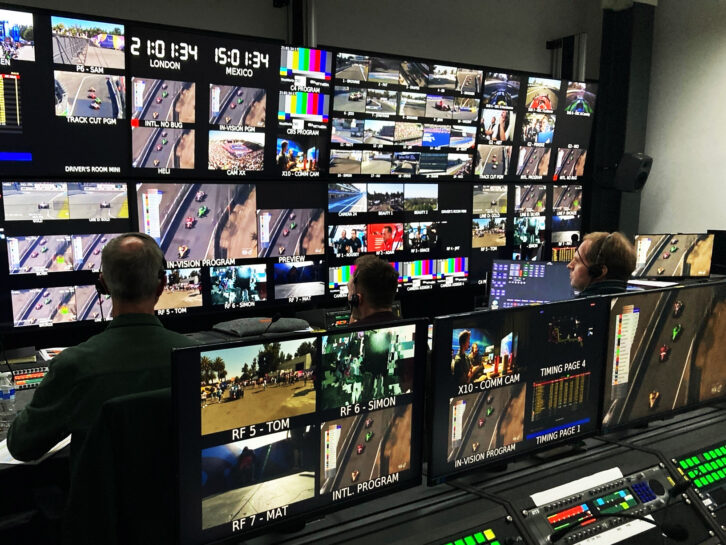Ed Tischler, managing director, Gravity Media, discusses the major trends the company has observed in live production during 2023, and how it’s preparing for major sporting events in 2024.
What industry trends have particularly stood out for you in 2023, and why?
There is a forever-growing high demand for content and remote production solutions in the industry. The demand for content continues to soar in 2023. Notably, the industry has adapted to the increase in remote production service solutions, allowing for more flexible and cost-effective content creation. This trend is a response to the changing landscape brought about by the Covid-19 pandemic and the need for remote production.
Despite the buzz around 4K HDR and other format changes in recent years, these technologies have not gained significant traction in the industry. Instead, the focus remains on sustainability and cost reduction. Clients and suppliers are increasingly mindful of the environmental and economic aspects of content production, emphasising efficiency and responsible practices.
We have noticed consumers appear to be less concerned about the specific format of content they consume at home. Instead, there is a growing interest in the responsible and sustainable production of content. The industry is facing pressure to align with consumer values, considering environmental impact and social responsibility as crucial factors in content creation.

Additional trends we have noticed include the increased push for production centres, the significant growth of esports and managed services as well as the growing Middle East region as a market.
As we launched our second London Production Centre in July 2023, the trend of establishing production centres continues to be a key focus in 2023. Centralised production hubs offer efficiencies in content creation and distribution, streamlining operations and reducing costs adding to the point of content being created in a sustainable way.
Furthermore, we have noticed even further the Middle East region is emerging as a key player in the global media and entertainment industry. With growing investments in infrastructure and content production, it’s an area of increasing interest for content creators.
With all these trends at the forefront of our minds, we take these factors into consideration for 2024 planning. The anticipation for major events like the Euros and the Olympics are significant drivers for the industry, with content creators and broadcasters gearing up for extensive coverage and innovative and sustainable ways of engaging audiences.
What impact are you seeing those trends having on the media and entertainment industry?
As a business, we continue to adapt to remote production. This shift requires investments in technology and workflows that facilitate collaboration and content capture from dispersed locations.
The above industry trends are driving a change in skill set requirements, especially on the technical front. There is a growing need for IP and network engineers who can ensure the seamless operation of remote production and content distribution systems.
The growth of esports and managed services is necessitating large-scale recruitment efforts. This expansion challenges both technical providers and regional talent pools to adapt to the unique demands of esports, making a transition from traditional broadcasting to this fast-growing segment.
The industry is paying close attention to the ever-changing freelance market. There is continued a push for diversifying and growing our talent pools. And there’s a collective effort to support and promote diverse talent among the next wave of media professionals, fostering inclusivity and fresh perspectives.
To keep up with evolving industry demands companies are investing evermore in training programmes to prepare the next generation of media and entertainment professionals. This includes not only technical skills but also a focus on sustainability and responsible production practices. Apprenticeships in our creative and technical recruitment are now even more integral to how we nurture talent through our business.
The expansion of non-traditional broadcasts into emerging markets creates new opportunities for Gravity Media and its team but it also requires a learning process to understand the cultural, technical, and regulatory landscape of these regions if it wants to be successful.
All of this impacts Gravity Media’s need for flexibility, adaptability, and a commitment to preparing a workforce that can thrive in an environment driven by technological advancements, sustainability, and a changing media landscape.
How do you see those trends developing further in 2024?
The esports market is expected to continue its rapid expansion in 2024. With a growing global audience and increased investments, esports will likely become an even more significant segment of the media and entertainment industry.
There will be continued emphasis on remote production. Advances in technology and the need for flexibility will keep pushing the industry to refine and expand remote production capabilities.
The demand for production centres is anticipated to keep growing in 2024. As businesses recognise the benefits of centralised production, we can expect more investments in these facilities to meet the industry’s increasing appetite for streamlined, sustainable, and cost-effective content creation and distribution.

These developments signify a continued evolution of the industry, driven by a combination of technological advancements, changing audience preferences, and the pursuit of operational excellence.
Do you expect to see any new trends within the industry in 2024, and what will they be?
The top three emerging trends within the industry we expect to see in 2024 are augmented reality (AR) in broadcasting, AI-powered content recommendation and metaverse integration.
As AR technologies become more sophisticated and accessible, we can expect to see their integration into broadcasting. This might involve immersive graphics, interactive elements, and enhanced viewer experiences, especially in sports and entertainment broadcasts.
AI and machine learning will play an increasingly prominent role in personalised content recommendations. Broadcasters may leverage AI to deliver tailored content to viewers, improving engagement and retention.
Both trends lead to the concept of the metaverse, which gained prominence in the tech and gaming sectors, and may start to influence the broadcasting industry. Companies might explore ways to create virtual worlds, interactive content, and social experiences that bridge the gap between traditional television and online communities.







